What is aquafaba and how to use the vegan egg substitute in meringues, pancakes, cake and mayonnaise
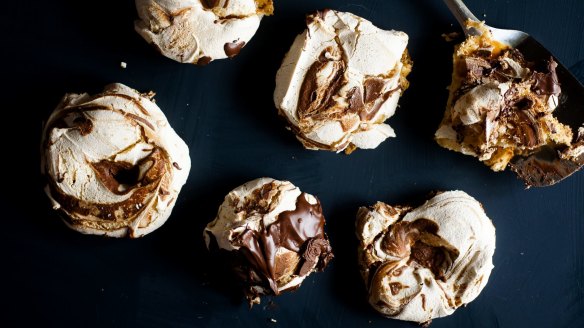
Aquafaba is a phenomenal tool in the vegan repertoire – facilitating so much texture and volume.
The low-down
Aquafaba, Italian for 'bean water', is the liquid strained from cooked legumes, and the most popular is chickpea aquafaba. It makes possibly the lightest most spectacular aioli (see recipe below) as well as meringues, cakes and most baked goods.
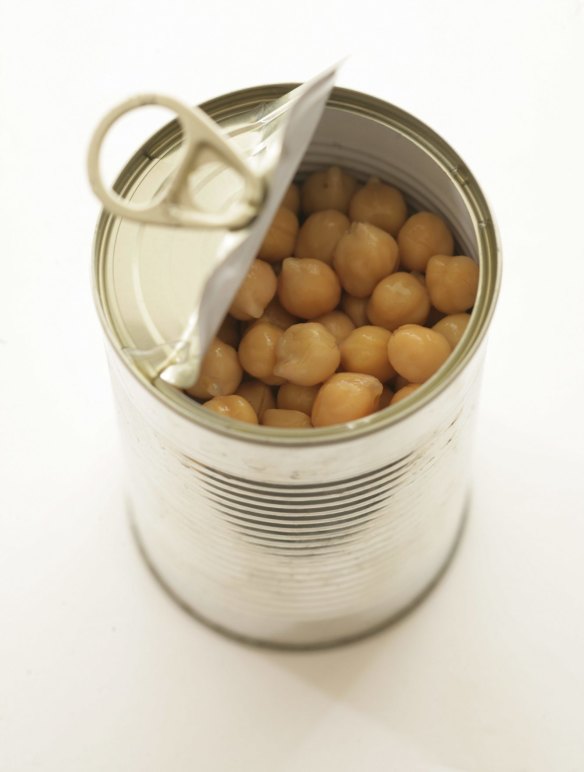
Aquafaba acts like an egg replacement, doing all the hard work – the lifting, the binding, the volume creating – and it's pure cooking gold.
How to use it
Aquafaba can replace eggwhites in a recipe, as well as whole eggs in baked goods.
Drain and reserve the liquid from cans of chickpeas (aquafaba liquid can be kept in a container). Transfer the liquid to the bowl of a stand mixer.
If you're using aquafaba as a binder, like whole eggs, you will have to lightly whip the liquid until foamy – not whipped. It should look like runny glue with bubbles.
As a meringue, you'll need to whip it for 10 to 15 minutes. It will take on the appearance of meringue – all tight high peaks and white and thick in consistency.
As a rough guide, three tablespoons of aquafaba will bind ingredients like one whole egg. Two tablespoons of aquafaba is about the equivalent of one eggwhite.
A few things to note
The liquid can be thick and gelatinous in consistency, or thin and runny, across different brands. If you are using it as a binding agent, it helps to use a more gloopy liquid. If you are making a meringue-style dish, it doesn't matter, simply whisk and whip a little longer and the results will be uniform.
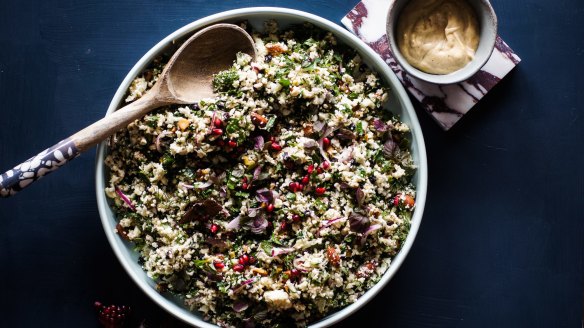
Cauliflower tabbouleh with smoked paprika aioli
This aioli is feather light. Aquafaba makes a spectacular mayo without the risk of salmonella from raw eggs. You will not know the difference.
INGREDIENTS
1 head of cauliflower, outer leaves and stems removed (about 500g once trimmed)
1 lemon, juice and zest
2 ½ tbsp currants
1 ½ tsp ground cumin
⅓ cup dill fronds
⅓ cup flat leaf parsley leaves
⅓ cup coriander leaves
½ cup pistachio kernels, roughly chopped
½ cup smoked almonds, roughly chopped
arils from 1 small pomegranate
Aioli
3 tbsp aquafaba from 1 can of chickpeas
2 tbsp apple cider vinegar
½ tbsp Dijon mustard
1 tsp brown sugar
1 clove garlic, crushed
pinch salt
1 cup neutral oil (such as ricebran oil)
1½ tsp paprika
METHOD
1. For the aioli, add all ingredients to the jug of a blender, cover and whizz to combine. It will thicken and take on a creamy appearance in about ten seconds. Store in the fridge until ready to use.
2. For the tabbouleh, add the cauliflower, a few pieces at a time, to a blender or food processor and briefly pulse into a grain-like texture. Transfer the blitzed cauliflower to a bowl as you go, so as not to overcrowd the processor.
3. Add the remaining tabbouleh ingredients to the cauliflower, except for the pomegranate arils. Add two to three tablespoons of the aioli and stir through. Season generously then turn out into a serving bowl, scatter over pomegranate arils and serve with the remaining aioli.
Serves 4
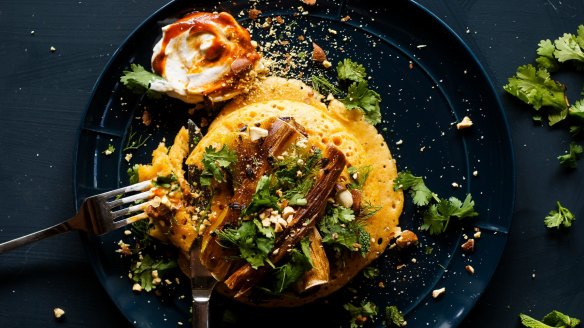
Aquafaba harissa pancakes with slow-roasted leeks, herbs and smoked almonds
INGREDIENTS
Leeks
⅓ cup rice bran oil
¼ preserved lemon, finely chopped
3 small leeks, washed and sliced in half lengthways
Harissa pancakes
135ml aquafaba liquid (drained from about 1 x 400g tin)
240g plain flour
pinch of salt
1 tsp baking powder
300ml almond milk
1 tsp dried thyme
1 tsp dried oregano
1 tsp ground cumin
½ tbsp harissa (or to taste; heat varies between brands)
coconut oil for frying
Topping
1 cup smoked almonds, roughly chopped
2-3 tbsp per serve coconut yoghurt
½ tsp hot sauce (optional)
METHOD
Preheat the oven to 160C
Place the leeks in a high sided roasting tray, pour over oil and scatter with chopped preserved lemon.
Roast in the oven for 45 minutes to an hour, or until the leeks are toasted, brown on top and soft to the touch. If you are concerned the pieces of chopped preserved lemon are taking on too much colour, cover the roasting tray with foil midway through cooking, and remove the foil for the last five minutes of cooking.
Whisk the aquafaba in a stand mixer, to stiff peaks (about 10 minutes).
In a separate bowl, add the flour, salt, baking powder and herbs then beat in the almond milk and harissa paste until smooth. Gently fold the whipped aquafaba into the batter.
Heat a non-stick frying pan over medium heat. Once hot, add a little coconut oil and swirl around the pan. Spoon a ladleful of pancake batter into the pan and cook. Wait until bubbles appear across the entire pancake (about 2 minutes) before flipping and cooking the other side for an additional 2 minutes. You will have to do this in batches, so keep the pancakes warm under foil or in a low oven until ready to serve.
Serve 1 to 2 pancakes per person, top with a few pieces of roasted leek then scatter with herbs and nuts. Dollop the coconut yoghurt to the side and top it with an additional splash of hot sauce, if using.
Makes 10 medium-sized pancakes
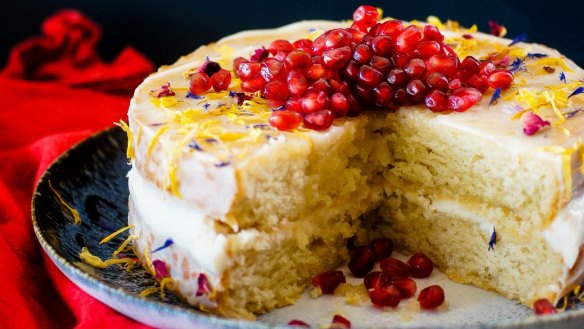
Aquafaba vanilla sponge with cream cheese frosting, maple and pomegranate
It might seem like a baking oxymoron to include meringue and baking powder for lightness and lift, then oil for richness, but it works marvellously well. The aquafaba and baking powder ensures a great crumb-like texture.
INGREDIENTS
330g flour
320g castor sugar
1 ½ tbsp baking powder
1 cup vegetable oil
1 tbsp vanilla bean paste
190ml almond milk
120ml (6 tbsp) aquafaba
Icing and decoration
230g vegan cream cheese, softened
½ cup icing sugar, sifted
arils of 1 pomegranate
1 tbsp maple syrup
dried lavender and petals (optional) to scatter
METHOD
1. Preheat the oven to 170C. Grease and line two 20cm cake tins.
2. Combine the flour, sugar and baking powder in a bowl.
3. In a small bowl, briefly whisk together the vegetable oil, vanilla bean paste and almond milk then slowly pour into the flour mixture and whisk until just combined.
4. In the bowl of a stand mixer with the whisk attachment, beat the aquafaba liquid until firm peaks are achieved (about 10 minutes). Add the batter mixture and whizz ever so briefly to just combine (about three seconds), enough to incorporate the ingredients, but not so much that the aeration of the aquafaba mixture is lost.
5. Divide the cake batter between the two prepared tins and bake for 35 minutes or until the sponges are lightly golden and spring back to the touch.
6. For the icing, add the cream cheese and icing sugar to a bowl and whisk to combine. Spread half the mixture across the top of one cake, then gently sandwich with the second cake. Spread the remaining icing over the cake. Top with the pomegranate arils and drizzle over the maple syrup. Slice and serve.
Serves 12
Double chocolate aquafaba meringues
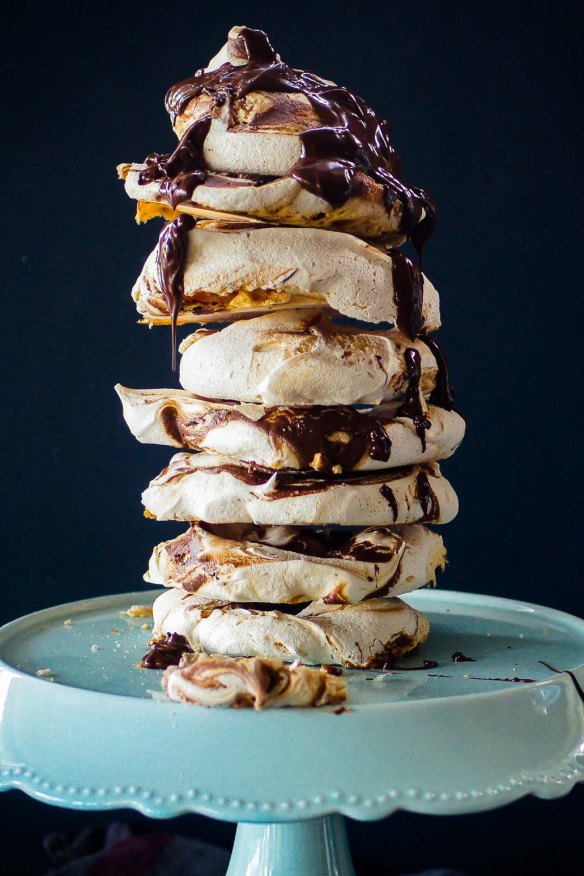
These meringues are wondrous. The snowy domes are shatteringly crisp on the outside and chewy on the inside – the way all good meringues should be.
INGREDIENTS
160ml aquafaba (drained from 1 tin of chickpeas)
1 cup castor sugar
1 tsp vanilla bean paste
100g vegan chocolate, melted and cooled
additional chocolate to drizzle
METHOD
1. Preheat the oven to 120C. Line a large flat baking tray with baking paper and set aside.
2. Using an electric mixer, whisk the canned chickpea liquid for 15 minutes or until soft to medium peaks form. Whisking constantly, gradually add the sugar, a spoonful at a time, and whisk until the mixture is thick and firm. Once stiff peaks form, add the vanilla and briefly continue mixing. Gently stir through the melted chocolate so it swirls through the meringue and creates a ripple.
3. Drop large spoonfuls (about two tablespoons of mixture) onto the prepared tray, 5cm apart. Bake in the oven for 1¾ hours or until meringues are firm to the touch. Turn off the oven, leave the door slightly ajar and leave the meringues inside until they are completely cool (about one hour).
4. Meringues (without additional chocolate drizzle) will keep in an airtight container for 3 days. Drizzle with additional melted chocolate (if using) just before serving.
Makes about 12
The best recipes from Australia's leading chefs straight to your inbox.
Sign up